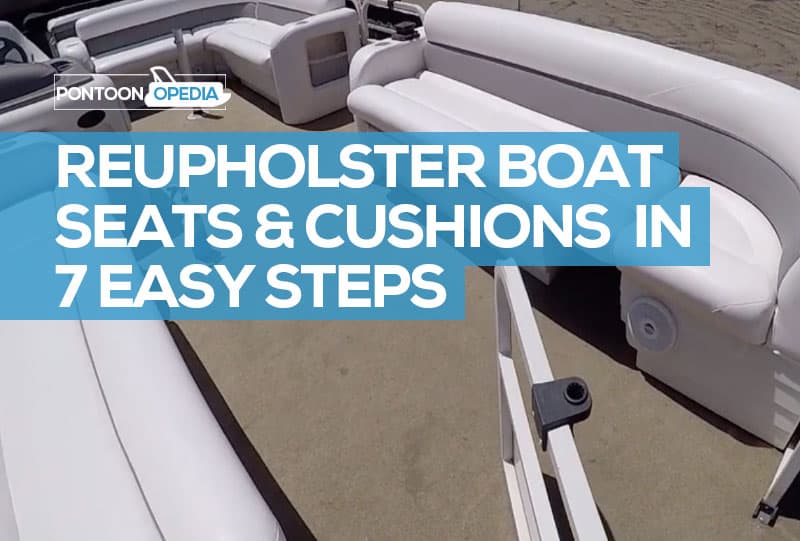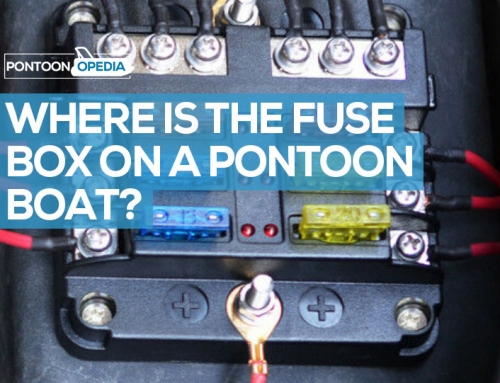If your boat seats are starting to show the ravages of time, you can get them looking as good as new with your own reupholster project. As well as replacing the boat seat vinyl and foam, it also gives you the opportunity to change up colors of the covers if you wish.
By learning how to reupholster boat cushions, seats, and covers you could also save yourself a lot of money compared to a professional doing it, or buying new seats completely.
I’ve done this project on my pontoon boat myself before (without sewing), and you can read through the step by step process below, including the materials and tools you will need if you want to know how to recover boat seats.
How to reupholster boat seats on a pontoon
The following step by step guide will tell you exactly what you need to do to reupholster your boat seats, whether that’s on a pontoon boat or otherwise. The process is exactly the same no matter what type of boat you have.
The method I will describe step by step is the staple gun method.
How to reupholster boat seats without sewing the covers
Instead of sewing you’re going to be using a staple gun. It’s a tried and tested method that almost anyone can do without needing to spend money on an expensive industrial sewing machine or having sewing expertise.
You can get really good results with this, and for the person who isn’t comfortable using a sewing machine, it can be quicker and easier.
What you will need:
- Marine-grade vinyl (view on Amazon)
- Foam padding (view on Amazon)
- Screwdriver
- China marker / grease pencils (view on Amazon)
- Sewing scissors (view on Amazon)
- Industrial stapler or carpet tacker (view on Amazon) with staples
Step 1: Measure up your vinyl and foam
You are going to be using your old boats seat covers as templates to cut the new vinyl.
What you can do in advance is remove one cushion and seat from your pontoon boat, then dissemble it using your screwdriver to lift the existing staples out from underneath.
Remove the old vinyl and lay it out on the floor and also inspect the foam padding. The padding might also need replacing if it’s got water damage.
By doing so, you should be able to calculate how much marine vinyl and foam needed for your DIY seat upholstery project – then go and order it.
Step 2: Buy the right sized vinyl and foam
I buy my marine vinyl on Amazon. You can see the which product I have used in the past by clicking here for replacement vinyl prices. It’s UV-resistant, water-resistant, very tough and comes in various different colors.
I would avoid darker vinyl covers as those shades absorb the heat, so can get very hot to sit on. That’s why most boat seats are in whites, creams, and paler tones.
If the foam also needs replacing, then you can also measure that up and buy it on Amazon again. I recommend a foam that is fire retardant, easy to cut, and with a long life.
The AK Trading upholstery foam ticks all those boxes (see foam prices) and you can buy it on the roll and then cut it to size.
You might want a different product though depending on how much compression and “sink” you want in your seats when sat on, so choose your foam carefully depending on what you are used to.
Step 3: Lay your new marine vinyl flat
Marine-grade vinyl for reupholstering boat seats will often come on a roll. That’s great for the delivery guy, but not great for you!
Once you get it, unroll it and lay it down flat with some weights on the ends. If you can let it sit in the sun this way for around half an hour, it will easier to work with and will make stretching over the seat construction in the next steps a lot easier.
Step 4: Use the old vinyl as a template to cut the new
Take your old boat seat cover and lay it face down onto the new vinyl. Using your grease pencil, make a trace around it as close as you can get to be a 100% accurate copy.

You can now cut the new boat seat shape out using a pair of sewing scissors (I gave you a link to Amazon further up the page to the ones I use).
Step 5: Place the foam and seat base onto the vinyl
New foam is optional as it depends on what state the old stuff was like and whether it needed replacing. If it does need replacing, use the template cutting method again to get the correct shape and size.
You might need to use an electric or Stanley knife depending on how thick the foam is, as the scissors might not cut it properly.
The process with old or new foam is exactly the same though; simply place the foam padding onto the newly cut set cover in a central position, and then on top of the foam place the wooden seat base on.
Step 6: Pull the vinyl tight and staple into place
Looking down onto the new seat arrangement, lean down and pull the front edge of the new cover up towards you and over the edge of the wooden part. Stretch it really tight, as tight as you can.
Now take your industrial carpet stapler or tack gun (use this one) and start stapling through the vinyl into the wood.
To keep the front vinyl part in place and fully stretched, staple just a couple of staples in first to keep it in position, as you can come back to it in a moment and then punch a staple every 2 cm to make it more secure afterwards.
You can now repeat this process with the back end of the seat cover, then the two opposite ends, just stapling them into position first with the vinyl pulled as tight as possible.
No start flipping the seat around so that you can place more staples in, with those 2cm gaps I spoke about.
And that’s it – you should now have new and fresh looking seat covers!
Step 7: Apply some vinyl protection spray
This is optional but can work wonders and keep the seats more weather-treated. Here’s a decent 303 vinyl guard that works on boats.
The vinyl I recommend is weather proof, but a little more protection with 303 can help if you want them to possibly last even longer!
How much does it cost to reupholster boat seats?
This depends on whether you want to do it yourself, pay an upholstery shop, or complete replace the seats from new.
#1: Typical costs for reupholstering yourself
I always look at DIY projects like this not just from a cost perspective of the materials, but also how much time it will take, and how well you can do the job to a high enough standard.
Marine-grade vinyl, a heavy-duty sewing machine, industrial stapler and new wood if needed can be very expensive, and sometimes it might be easier (but not cheaper!) to pay an upholstery store, as you can see in the next section.
- The vinyl materials can cost around $20 a yard
- An electric staple gun can cost $30 to $50 if you can do it without sewing
- An industrial sewing machine can cost up to $800 for a proper job
- Foam padding costs unknown as will vary wildly
Here’s what a person on Facebook said about reupholstering their pontoon boats seats themselves:
“It cost us less than $300. We used some upgraded materials for the backs, a stapler, and then had some different colors and styles for the seat accents.”
#2: Typical costs for paying an upholstery shop
If you don’t have the skills and equipment, it will be far easier to pay an upholstery shop to reupholster your pontoon boat seats.
However, prices will vary wildly depending on where you are and how many seats and cushions you need replacing and reupholstered. It can be very expensive to use a specialist reupholster shop, it can even sometimes cost more than buying new seats altogether.
For example, a buddy recently paid $450 to get just two cushioned recovered in marine vinyl, so can’t imagine what his local upholsterer would have charged to do the whole boat.
I also found someone on Facebook saying:
“I had all 9 of my 3-foot seats sections upholstered at a shop for just $1,800 dollars. If I was to buy those seats from brand new, I would have been looking at $3,000 instead.”
In the case above it was actually cheaper for him to use a reupholstering store.
Many people who have done this say that it costs about the same price to recover the seats using a specialist tradesperson as it does be buy new ones.
#3: Typical costs for replacing the boat seats
I have a 22-foot pontoon boat and looked up the price to get the seats completely replaced from manufacturer and dealer websites.
I was quoted a price of $1,500 to get replacements for the L-shaped rear bench, console, captain’s chair and two fishing seats.
There is no rule of thumb here though, as the prices will vary depending on how many seats you need to replace and who you decide to buy from, including quality considerations.
I would suggest that buying from new will give you a longer seat life compared to reupholstering yourself as a DIY project.
Is it cheaper to reupholster your boat seats or just buy new?
I asked the question above on a pontoon boat forum, to find out what people’s real-life experiences were when either buying new seats or having them reupholstered and how the prices compared. For example, was one way cheaper than another.
Here is a selection of the best comments from what other people say.
“I spent just over $3,000 on new boats seats and cushions from Veada on a 30-foot Party Hut, and that wasn’t including the back-sun deck. It would have been an extra $450 dollars on top if I had used my local upholstery shop. The seats were great quality and you can pick your colors with just a 3-week lead time.”
“When I was looking for replacement seats it was about the same price and not really much cheaper than paying for reupholstering. Our new ones are great because they come with new bases and foam. If you decide to reupholster the old ones you still have to resolve the old foam and old wooden bases.”
“I believe you will always be much happier with new seats. I just got done restoring my own by buying a complete new set. I did contemplate a full reupholster as sometimes you can get a better quality if you use a professional restorer. It’s worth learning how to recover boat seats for sure!”
“We almost always recommend new seats, unless bought direct from an actual pontoon manufacturer as they tend to of a lower quality material and more importantly the stitching isn’t always that great.”
“Go with a quality upholsterer. If the bases are in good shape, then the foam can be steamed to bring back it’s bounciness. They will also use materials that are far better than even the original and they can make it exactly how you want it. Yes, you are going to pay more because it’s quality. I’ve seen the aftermarket seats, and you’ll be in the same predicament in 5 years or sooner. Just my two cents.”
“Getting them reupholstered can often cost the same or more than buying new seats. Instead I spend $300 on materials plus $800 on an industrial sewing machine and doing mine right now and so far, so good. You can buy all new seats for half of what it costs to reupholster them.”
“When I restored my first pontoon boat, I bought all new seating. It was cheaper, but it did actually look that way too. None of the pieces fitted up against the radius of the fencing the way the OEM stuff does. On my second pontoon boat I took all the interior out and brought it to a local upholstery shop. It was more money for sure, but a way nicer finished product.”
“I got a quote to redo my 24-foot standard layout pontoon which came in at $2,400. New online the seats would have cost about $2,500. We are finishing doing it ourselves for about 15% of that price. It is taking some time but pretty easy.”
“We priced ours both way and the cheapest estimate to recover was $3,300 dollars and our seats had wooden bases. In the end we bought all new seating with plastic bases for $3,400 plus with loungers.”
How to reupholster boat seats video tutorials
If you want to see some real-life examples where people are already done similar projects and documented them on YouTube, then here’s a selection of some of the best.
Video 1: Reupholstering a back to back lounge seat
Video 2: How to upholster vinyl side panels
Video 3: Reupholstering pontoon boat seats and cushions
Tips for reupholstering your boats seats
#1: Color tone and shade choice
Most boat seats tend to come in lighter colors, and there’s a good reason for that; they aren’t as hot when you sit on them!
Dark colors will absorb heat so stick to lighter colors as the main color shade, possibly just keeping any darks for the secondary tone in strips and panels.
#2: Grooves, raised patterns, and seams
Try to avoid deep grooves in the vinyl seats as it can tear over time. If you can, have them reinforce the seams to help with tearing.
With deeper grooves and pleats you will find it harder to keep the mold, mildew, and dirt out. It will make cleaning a lot harder (you can read seat cleaning tips here).
By choosing smoother seats you won’t have this annoying problem.
#3: What if the wood is rotten?
Earlier I mentioned that the foam aspect of boat seat reupholstering is optional, depending on the state of the foam. In really bad cases, you might get a nasty surprise when you take the seats up and apart as the wood could have rotted through.
I’ve never had to replace the wood before myself, but if it is in bad shape, don’t even think about putting new foam and vinyl over it as the damp trapped inside will ruin your new project over time.
You will have to completely remove the seat and replace the wood.
#4: Will you get better results if you sew instead of staple?
Having never sewed, I can’t give you my personal opinion, but I do know it will take longer. The results and seams can be replicated better, but for most pontoon owners, you might not want to go that far.
A professional upholsterer will use sewing, but they have sewing machines that can cost in the 4 figure range.
#5: UV and weather resistance
If you are buying new seats or marine vinyl to do the job yourself, always opt for a UV resistant material. It will stand up much better in the sun and won’t fade or crack as much over time.
Something else that will also help is to use Scotch Guard on the seats when they are brand new as this will help to keep the water out.
#6: Cleaning your new seats
To stop your new seats getting into the mess they got into before, I recommend regular cleaning. You might also be able to save the seats and cushions you already have with the methods below, before embarking on a reupholster project.
- Using Magic Eraser to keep your seats clean
- Why I don’t recommend using vinegar to clean your boat seats
- How to clean mildew and mold from vinyl seats
The last word…
Buying new boat seats is expensive and having a professional upholstery company do it for you can sometimes cost even more money than teaching yourself how to recover boat seats yourself.
Given that the materials and tools often needed are actually very cheap, it’s a DIY project that I feel you could get completed in a weekend.
I hope that the steps above help – they don’t cover and complex sewing or seams, but in most cases will let you get your covers and cushions looking like brand new again.
I reupholstered my pontoon boat seat covers, so reckon you could too!
Handy Hint: Captain’s chairs aren’t easy to re-upholster due to the intricate design. They are simple to replace though. To see which skipper chairs I currently recommend for pontoon boats, click here.










